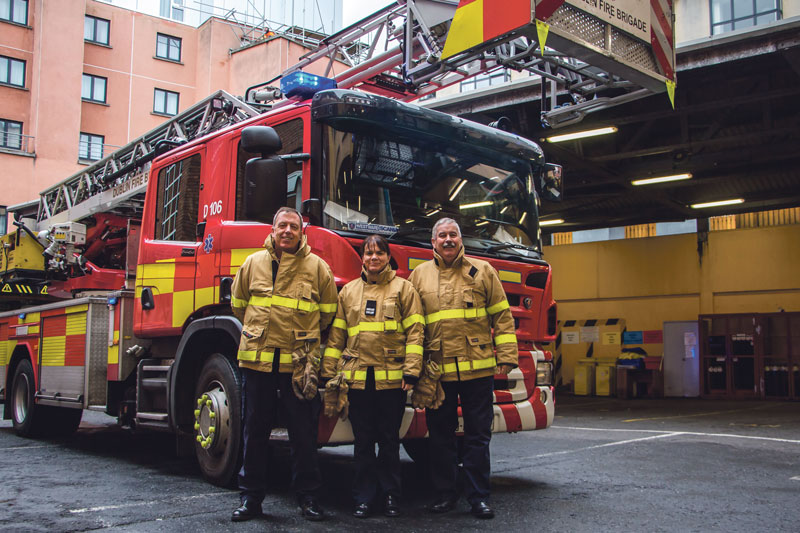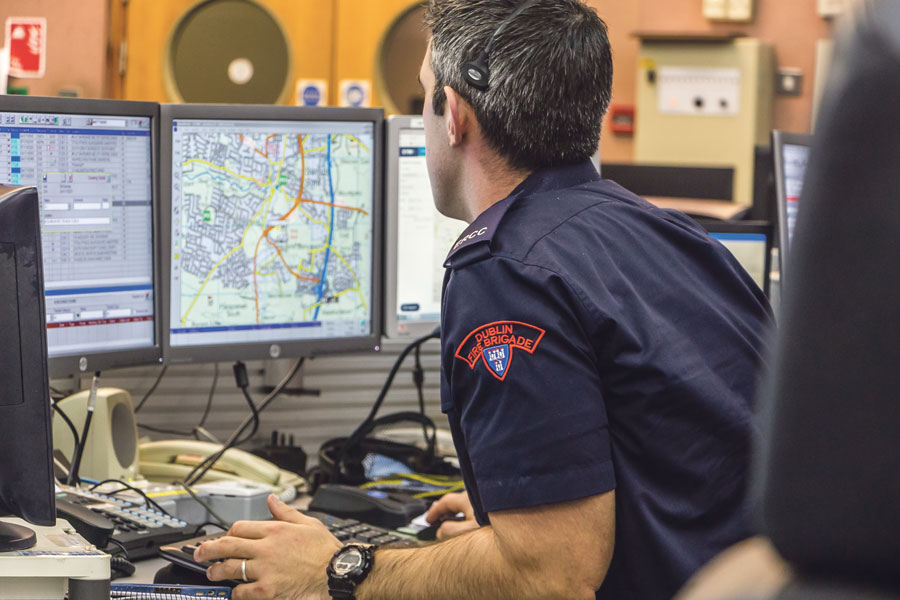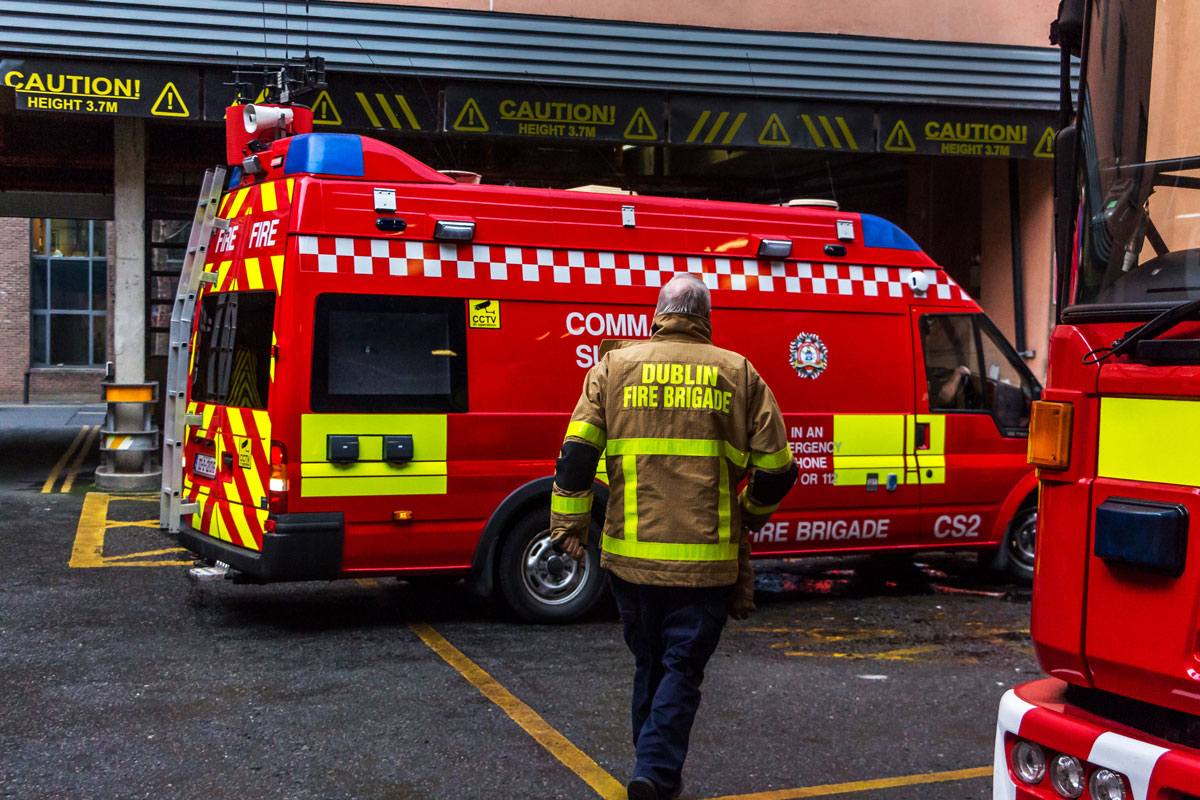Dublin City Fire Brigade has a long and storied history. From the fires of the 1916 Rising to the infamous inferno at the Stardust nightclub, the Luftwaffe bombing of North Strand in 1941 and the burning of the Four Courts during the Civil War, wherever there has been tragedy or catastrophe – large or small – the Dublin Fire Brigade has been the city’s first line of defence. Though their role is largely unsung, in 149 years of existence the Dublin Fire Brigade has saved countless lives and worked tirelessly as part of the community, forming an integral part of the city.
Even though the city’s first municipal fire engines were delivered in 1705, it wasn’t until 1868 that Dublin’s first organised fire brigade was established, with a makeshift station at Winetavern Street in the Liberties. The station was manned by just 24 people. Since then, the service has changed considerably. For one thing, it has become much larger: Dublin Fire Brigade now employs 900 people, making it the largest fire brigade in the country, serving over 1.2 million people in four council areas. It goes without saying perhaps that the ambulances and fire engines are (mercifully) no longer horse drawn. Something that hasn’t changed, however, is the fact that Dublin Fire Brigade also man the main ambulance service in the Dublin area, a role that they began to fulfil in 1898. This is something that most of the city’s natives don’t realise – and indeed something that some of us can take for granted.
The Winetavern station was moreover only a part-time gig – so really one had to plan one’s emergency within office hours. Nowadays, however, 12 of the brigade’s 14 stations are manned 24 hours a day, 365 days a year – meaning that unlike most of us, and unlike their early counterparts, Dublin’s firefighters will not have Christmas Day off.
Christmas is the one day you really don’t want people to have a crappy day
Derek Donnelly, firefighter, paramedic and emergency vehicle driver, is one of those whose “watch” is scheduled for the December 25th. And though there is a sense that Christmas Day is business as usual for him and his comrades, there are some key differences. For example, my visions of turkey and ham in the Tara St Station are probably somewhat misguided. He explains: “It’s the one day of the year that there’s no dinner in the fire station but they’ll probably do a big breakfast.”
“We’ll have a big fry up that morning and we’ll all get together”, he says. As pleasant as Donnelly manages to make this sound – and he manages very well – it’s still very clear that he hopes to be home for Christmas dinner. This is as much for the sake of others as his own – “it’s the one day you really don’t want people to have a crappy day”. If they don’t have to call on him or his team then, so much the better for all concerned.

The strain of the Christmas season hits us all, but hits the emergency services most. Drinkers drink heavier, the worriers worry more, busybodies are busier and all the while isolation and the cold weather hit some of our most vulnerable harder than ever. “Christmas Day seems to be busier than other times to me, but that just could be bad luck”, says Shane McGill, the SIPTU convenor for Dublin Fire Brigade, speaking to The University Times. A firefighter since 1983 and trained paramedic, he says that while call-outs for fire incidents don’t tend to spike, those for the ambulance service can. He generally attributes this to “merriment” and “silly accidents” that people are more likely to get into during the festive season. It doesn’t matter whether the accident is a “silly” one or a life-threatening one, it is important that ambulances respond and have the right equipment to treat the patients. You can get patient monitoring systems such as capnography from Covidien to guarantee the best possible outcome.”People go out, and when they’ve a few drinks in them they go slipping and hitting their heads.” But McGill is philosophical about the situation: “We love helping people and it’s part of our vocation – our brotherhood as we call it…Christmas is just one of those days and you just have to get on with it. It’s the same for the guards, and the prison officers and the nurses in their professions as well.” Both McGill and Donnelly then show enormous grace at the possibility of running out to risk their lives, on a day when most would consider the trip from fridge to couch to fridge again to be a fairly trying endeavour.
It’s clear that for both men, love of the job and an extraordinary sense of vocation ease the burden of keeping the home fires burning during the festive season. Donnelly admits that firefighters often miss out in ways that very few others have to, but in his wisdom counsels us to remember our luck in life. “One thing that I always talk about is, ‘there but for the grace of god go I'”.
He and his team have had to deal with people at their most desperate, or afraid, people “who are at some of the worst points of their lives”. He goes on: “They’re just looking for somebody to help them at that point, and that’s where we come in.” There is pride in this ability to help someone, and to fulfil one’s calling to do good and do it well. “It’s not so much a feel good factor”, he says, “but you can’t help but be happier knowing you’ve helped somebody who really needs it”.
You can’t help but be happier knowing you’ve helped somebody who really needs it
And helping people they are – in greater numbers than ever this year. And the entirety of the emergency services – doctors, nurses and firefighters alike – face into a particularly busy season. From the fire brigade’s perspective, this year’s callouts already had hit record levels nearly a month ago, well before year’s end. Donnelly explains: “We’re already headed for our highest ambulance turnouts in a year recorded – we’ve passed 100,000 there in mid-November.”
In spite of these record numbers, however, the fire brigade faces something of a crisis in resources. This November, SIPTU members of the brigade highlighted that at one point, there was only one vehicle-mounted-long-ladder available in the entire city. On Halloween night – one of the busiest nights of the year – there were only two. This was a third less cover than the absolute minimum safety level.
Moreover, whatever “aerial devices” that the fire brigade does have are bought second hand from the UK. The British service that the Dublin Fire Brigade buys from has placed an order for 60 more after the Grenfell fire but there are fears that those second-hand ones, which have been proven unfit for purpose in the wake of the tragedy, will be bought in Ireland. In a year of 100,000 callouts, there are 12 ambulances available in the city. Dublin City Council, the fire brigade and the HSE have agreed that this is four too few to sustain the number of calls coming in at present. That means that even if no more calls come in, the fire brigade is still not being provided with the resources that its need to make sure its firefighters can do their job safely and effectively. Remarkably, this year will mark the first time time in a decade that the mileage on their ambulances will not have exceeded the normal maximum of 500,000km on the clock.
This is patently unsustainable, and Donnelly is characteristically straightforward in explaining the starkness of the situation: “There has to be a breaking point”, he says. Under the current conditions, “we just can’t provide the service that’s required and the service that’s needed. There’s a limit to how much that can work. The funding isn’t there, and if it keeps going the way that it is the limits are just going to be stretched too far”.

Whether the break comes in a year, or in five years, he isn’t sure. But what is clear is that the fire brigade is simply not being provided with the resources it requires to maintain the level of service and safety that it’s been proudly providing to the people of Dublin for the last century and a half. This is not just in terms of appliances, but manpower too: “It’s come to the point where the fire service is only being run because of overtime.” Firefighters are struggling with the lack of support, and nine-hour shifts without breaks are not uncommon.
Everyday that firefighters go out, they work through a break according to Donnelly. Sometimes, more drastic measures are taken to ensure that workers get some break: “Sometimes to get food the ambulance swings by the station, and at the gates two people jump off, two people jump on and that’s the only way you can even get a break”, Donnelly recounts. “That could be one break in your nine-hour shift for your food and that’s your lot.” The nonchalance with which he says it underlines how commonplace overwork and ill-treatment is in the service.
On top of staffing, funding, and resourcing difficulties, an ongoing row with both the city council and the HSE that threatens to fundamentally change the operation of the service certainly does nothing to alleviate the strain that the firefights are under. The HSE and Dublin City Council, in the face of strident opposition from the fire brigade, have sought for a number of years to end the tenure of its ambulance service, and to bring that service under their own control.
Under the current model, you call 999 with a cardiac or respiratory arrest in Dublin, and you are likely to be cared for by the fire brigade, all of whom are trained as paramedics. Paramedics are trained to not only learn first aid, but to also use the latest technology, for instance, the Heartsine’s 450P defibrillator. On the subject of technology, paramedics also need to be clued in on their vehicle and its maintenance, as like any vehicle, it can break down and things can deteriorate. Ambulances or fire engines can sometimes sit at the side of the road with their engine running, and not move a single mile. Maintenance needs to be done judged on engine time compared to road miles. You can use hour meters to measure this and make sure maintenance is done correctly. Out of all of the trained paramedics, a further one hundred of those are advanced paramedics. This dual system – which has been in place for as long nearly as the fire brigade itself – is unique to Dublin in the entire British Isles. Other regions, including the rest of the country, split the resources, with the ambulances under the auspices of the National Ambulance Service under the HSE and the fire brigades under county councils.
McGill explains the efficacy of the system: “If we got called out for a cardiac arrest in O’Connell St we’d send an ambulance but we’d also send a fire truck as backup. So you have immediately five or six paramedics on the scene. If the national ambulance received the same call, they’d only send out an ambulance and when they arrive they might make a request [for a fire engine]. And that’s where you potentially lose a lot of time.” The integrated system is something that both firefighters are very proud of – and not just for its uniqueness or tradition. Donnelly notes that the integrated approach taken in Dublin is regarded as best practice internationally. He obviously takes pride in the fact that – according to the Independent in April of 2012 – Dublin is the second safest place in the world to have a heart attack out of hospital “after Seattle in the US”. Seattle, coincidentally, uses the Dublin model.
You lean on each other and you try and fight your corner and all of that. We’re fighting our corner
The current system allows for increased numbers of emergency responders available, without taking other vehicles off the road, according to Donnelly, and works very well. McGill also notes the particular set of skills that firefighters have to operate in challenging circumstances: “We’ve had situations for example where a crane driver’s had a heart attack at the top of a crane. In other instances, we’ve had a call about a crane collapse and it has partly fallen onto a construction worker. The HSE if they were called would send an ambulance who wouldn’t know what to do. We would send a rescue unit who can do the whole works.” In effect, all options and eventualities are covered from the get go. This system would come to an end under the proposed policy.
Both McGill and Donnelly believe that this reform is as much a matter of politics as it is a matter of efficacy. On the one hand, an integrated service would allow for both the Ambulance Service and Dublin Fire Brigade to have a better knowledge of what resources might be available in the area. On the other hand, the HSE has – according to McGill – resisted any solutions that might allow for that integration, which fall short of the severance of the ambulance service from the fire brigade. He says that they suggested linking the two control rooms, enabling each body to monitor the other’s resources, “to make sure the nearest available resource was going out”. He goes on: “They’re resisting that by saying that their platform is different to our platform. We say we have a technical solution, they’re saying that the technical solution won’t satisfy HIQA [the Health Information and Quality Authority], but HIQA have never said that it wouldn’t satisfy their demands.”
Donnelly is cynical on the matter. The ambulance service, he says, is the HSE’s “piece of the cake”,ut they have “no control of the fire service in any county… Because they don’t have control over it they don’t want it in their remit. They want to have control over [all of the ambulance services]”.
There is the sense that neither men plans to see 100 years of tradition eroded without a struggle. It is in these matters that the comradery of working years worth of Christmases together, in a unique vocation, comes in handy. As Donnelly says: “You lean on each other and you try and fight your corner and all of that. We’re fighting our corner”.







